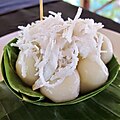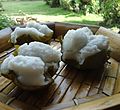Glutinous rice
Glutinic acid is a chemical compound that belongs to the class of organic compounds known as carboxylic acids. It is also known as pentanedioic acid due to its structural similarity to pentane, with two carboxyl groups replacing two of the hydrogen atoms.
Chemical Structure[edit]
Glutinic acid has the chemical formula C5H8O4. It consists of a five-carbon alkane chain, with a carboxyl group (COOH) at each end. This structure is reflected in its systematic name, pentanedioic acid, which indicates a five-carbon chain (pentane) with two carboxyl groups (dioic acid).
Properties[edit]
Glutinic acid is a white, crystalline solid at room temperature. It is soluble in water and can be dissolved in various organic solvents. It has a strong acidic taste and is non-toxic. The acid is a dibasic acid, meaning it can donate two protons per molecule in solution.
Synthesis[edit]
Glutinic acid can be synthesized through the oxidation of cyclopentanol or cyclopentanone with potassium permanganate. It can also be produced from the oxidation of glutaryl chloride with water.
Uses[edit]
Glutinic acid is used in the manufacture of plasticizers, resins, dyes, and pharmaceuticals. It is also used as a laboratory reagent in various chemical reactions.
Safety[edit]
As with all carboxylic acids, glutinic acid should be handled with care. It can cause burns and eye damage, and its dust can cause respiratory irritation.
See Also[edit]
Glutinous_rice[edit]
-
Chapssal (glutinous rice)
-
2014 uncooked Thai glutinous rice
-
Glutinous Rice Flour
-
Num Plae Ai
-
Pearl Meatballs with Sticky Rice
-
Steaming rice
-
Lao cuisine ricebasket
-
Sticky Rice Myanmar
-
Puto in banana leaf
-
Poblacion Baliuag Bulacan
-
Puto-bumbong
-
Kuchinta at Gerry Shan's Place Baler
Ad. Transform your life with W8MD's Budget GLP-1 injections from $75


W8MD offers a medical weight loss program to lose weight in Philadelphia. Our physician-supervised medical weight loss provides:
- Weight loss injections in NYC (generic and brand names):
- Zepbound / Mounjaro, Wegovy / Ozempic, Saxenda
- Most insurances accepted or discounted self-pay rates. We will obtain insurance prior authorizations if needed.
- Generic GLP1 weight loss injections from $75 for the starting dose.
- Also offer prescription weight loss medications including Phentermine, Qsymia, Diethylpropion, Contrave etc.
NYC weight loss doctor appointmentsNYC weight loss doctor appointments
Start your NYC weight loss journey today at our NYC medical weight loss and Philadelphia medical weight loss clinics.
- Call 718-946-5500 to lose weight in NYC or for medical weight loss in Philadelphia 215-676-2334.
- Tags:NYC medical weight loss, Philadelphia lose weight Zepbound NYC, Budget GLP1 weight loss injections, Wegovy Philadelphia, Wegovy NYC, Philadelphia medical weight loss, Brookly weight loss and Wegovy NYC
|
WikiMD's Wellness Encyclopedia |
| Let Food Be Thy Medicine Medicine Thy Food - Hippocrates |
Medical Disclaimer: WikiMD is not a substitute for professional medical advice. The information on WikiMD is provided as an information resource only, may be incorrect, outdated or misleading, and is not to be used or relied on for any diagnostic or treatment purposes. Please consult your health care provider before making any healthcare decisions or for guidance about a specific medical condition. WikiMD expressly disclaims responsibility, and shall have no liability, for any damages, loss, injury, or liability whatsoever suffered as a result of your reliance on the information contained in this site. By visiting this site you agree to the foregoing terms and conditions, which may from time to time be changed or supplemented by WikiMD. If you do not agree to the foregoing terms and conditions, you should not enter or use this site. See full disclaimer.
Credits:Most images are courtesy of Wikimedia commons, and templates, categories Wikipedia, licensed under CC BY SA or similar.
Translate this page: - East Asian
中文,
日本,
한국어,
South Asian
हिन्दी,
தமிழ்,
తెలుగు,
Urdu,
ಕನ್ನಡ,
Southeast Asian
Indonesian,
Vietnamese,
Thai,
မြန်မာဘာသာ,
বাংলা
European
español,
Deutsch,
français,
Greek,
português do Brasil,
polski,
română,
русский,
Nederlands,
norsk,
svenska,
suomi,
Italian
Middle Eastern & African
عربى,
Turkish,
Persian,
Hebrew,
Afrikaans,
isiZulu,
Kiswahili,
Other
Bulgarian,
Hungarian,
Czech,
Swedish,
മലയാളം,
मराठी,
ਪੰਜਾਬੀ,
ગુજરાતી,
Portuguese,
Ukrainian











